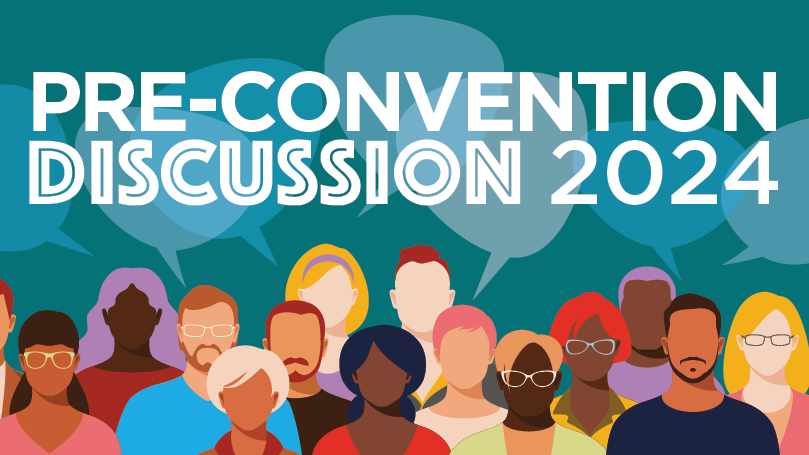
This piece is a contribution to the Pre-Convention Discussion for our 32nd National Convention. During Pre-Convention Discussion, all aspects of the party’s program, strategy, and tactics are up for consideration and debate. The ideas presented here are those of the author or authors alone, and do not necessarily reflect the positions of the Communist Party USA, its membership, or their elected leadership bodies. — Editors
Authors’ Note: This is not a critique of party policy, organization, leadership, or history. It is meant to learn from our past to inform our future.
The party has been in a serious rebuilding phase, building a new party in this new socialist moment amidst an imperialist crisis and fascist danger in the country. These crises and the reality of which we live in, where the social movements are, and the level of class and socialist consciousness, shape how we approach our work while using the science of the working class, Marxism-Leninism.
The Communist Party of the United States, throughout its history, has participated in some of the sharpest working class struggles in this country’s history which have led to significant democratic gains and has fended off the threat of fascism since its inception. One of these lesser-known gains is the desegregation of the federal prison system when former Harlem council member, Benjamin Davis, was imprisoned under the McCarthyite Smith Act and Communist Control Act. Another, led by Benjamin Davis during his years as a leading lawyer in Georgia, was the desegregation of juries into multiracial jury selections, which were typically all white and male. These were battles won during the rise of the International Labor Defense and the international campaign to free the Scottsboro Nine and the Civil Rights Congress’s leadership in fighting to free the leadership of the Communist Party during the McCarthyite period of the 1950s.
In the 1970s, the party led a major national campaign for the freedom of Angela Davis, when she was incarcerated under conspiracy charges related to the Soledad Brothers and Jonathan Jackson. That campaign ultimately led to Angela’s freedom and the founding of the National Alliance Against Racist and Political Repression, which follows the same lineage going back to the International Labor Defense of the 1930s.
For the party to rebuild in this current moment, it needs to take a serious look in the mirror and at its history to think about how it builds a major campaign for social and political change. This will require the party to elect an organizational secretary of the National Committee, who will be tasked with building national initiatives of the party in party districts and clubs. An organizational secretary is necessary in building the party and building its core of cadre. The incoming National Committee also needs to determine its priorities going forward and consider building a national campaign and initiative that may be initially driven by one of its organized commissions.
Will this be a campaign within the peace movement, within the Black freedom movement, within the environmental movement, within the housing movement, within the labor movement, etc. or a combination of these?
The party has played a special component role within broader movements of the past decade or so, but has not expressed its leadership in a major way, which leads to people saying, “does the Communist Party still exist?”
This leads me to my next point: the role of the mass organization and the party’s relationship to it. As mentioned above, organizations like the International Labor Defense, National Negro Congress, Civil Rights Congress, National Alliance Against Racist and Political Repression, and others, were all initiated and led by party members. The mass character of the party will look different in each geographical area of the country where the party is organized. It may take the form of a labor organization, a civic organization, a mass defense organization, a youth organization, a women’s organization, a Marxist school, etc. The point of these organizations is to not only to break the barrier of anti-Communism that persists in the United States, but to have a broad approach to issues that may include non-Communist forces. The Claudia Jones School for Political Education in Washington, D.C. is a recent example of this. The party in each district needs to initiate different organizations with mass character to organize progressive forces locally, apply the communist-plus, and to bring masses of people within the influence of the party’s politics and program.
Finally, the local party clubs and mass organizations cannot be sustained and consistent in the community without a major effort to build its fundraising and financial infrastructure. The party used to operate bookstores, community and workers centers, schools and more. These were sources of not only income, but also to organize consistent programming in the neighborhoods that the party operated in and gave a sense of community among comrades and friends alike. There needs to be an initiative in these coming years to develop a serious economic plan for the party to bring in large sums of income to begin building the party around the entire country. Every party district should have a goal of opening a storefront or a house or workers center that could give the party more opportunities to build deep relationships in the community. This should be another priority for an elected organizational secretary regarding long-term goals for districts and clubs. Yes, it is difficult to maintain and manage a space, especially with rental and real estate costs these days, but we should not sell ourselves short in terms of the fight for public spaces throughout the country.


 Join Now
Join Now